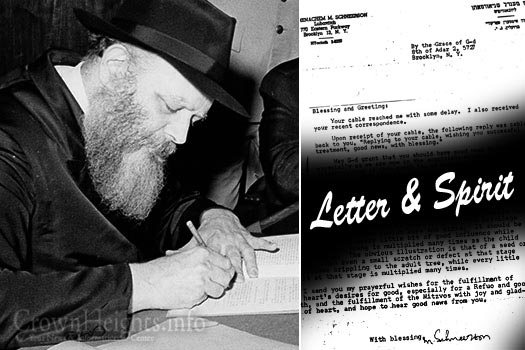
Letter & Spirit: How Many Elements Are There?
In this week’s edition of Letter and Spirit, we present a letter from the Rebbe in which he explains the four basic elements as taught in Tanya, and explains them within the context of the over-one-hundred elements taught in science. The letter was written in English through the Rebbe’s trusted secretary Rabbi Nissan Mindel, and was made available by the latter’s son-in-law, Rabbi Sholom Ber Shapiro.
This weekly feature is made possible by a collaboration between CrownHeights.info and Nissan Mindel Publications. Once a week we publish a unique letter of the Rebbe that was written originally in the English language, as dictated by the Rebbe to Rabbi Mindel.
**********
By the Grace of G-d
18th of Tevet, 5720
Brooklyn, N.Y.
Mr. ________
Baltimore, Maryland
Greeting and Blessing:
I received your letter, in which you ask my explanation of the reference to the four “basic elements” (yesodot) mentioned in Chapter 1 of the Tanya, and you ask how is it possible to reconcile this with modern chemistry which recognizes over one hundred elements.
Prefatorily, I must make at least two corrections in your letter. One, the origin of that statement in the Tanya is not as you write, but it is found in the Midrash Rabba Bamidbar, and at greater length and in greater detail in many parts of the Zohar, and further explained in other books of Kabbalah. Two, modern chemistry does not recognize over one hundred basic elements, but a considerably fewer number if matter is to be reduced to its basic components or particles. [For the so-called elements are themselves made up of atoms, which are the smallest particles into which an element can be divided and yet retain its properties and the characteristics. The atoms themselves are further made up of smaller particles,] such as electrons, protons, neutrons, etc.
Thus, the answer to your question already lies in the proper definition of the terms under the discussion. For, as indicated above, a so-called element is not the most basic particle of matter. Even the term “atom” which originally meant something indivisible, is an archaism now employed only for convenience, as it no longer corresponds to its original meaning. Similarly, when we speak of an individual as being an element of society, this does not mean that the individual himself is not a composite.
This should be borne in mind when we consider the term Yesodot in the Zohar, Midrash Rabba, Kabbalah, etc., and of course, in the Tanya and other Chabad sources. This does not mean something which under normal circumstances is indivisible or unchangeable, but the actual so-called “bricks” or truly basic components which make up everything that exists in the world. I might also mention that there is another school that conceives these four Yesodot, not in their physical aspects, but rather qualitatively, that is to say, “fire,” in the sense of the properties of heat and dryness; “water,” in the sense of coolness and humidity, and so on.
I hope this will answer your question, and if you have any further question, do not hesitate to write again.
With all the good wishes, and
With blessing,
**********
The above letter is from the second volume of The Letter and the Spirit by Nissan Mindel Publications, in the Torah and Science section. The letters are from the archives of Rabbi Dr. Nissan Mindel, a personal secretary to the Previous Rebbe and The Rebbe, whose responsibilities included the Rebbe’s correspondence in English.
We thank Rabbi Sholom Ber Shapiro, director of Nissan Mindel Publications and the one entrusted by Rabbi Mindel, his father-in-law, with his archives, for making these letters available to the wider public. May the merit of the many stand him in good stead.













non-gender
Very interesting reply both in the scientific and the Kabbalistic approach. Remember when Einstein’s theory was believed to be the ultimate answer. In other words, we are challenged to expand our understanding as much as possible within our finite ability to understand the greatness of HaKodesh, Boruch Hu’s creation and to realize that there is no finite limit and “jack in the box categorizations” to it– even without the limitations of Hubel as The Rambam stated in his Mitzvoh of “To Know G-D. As for me if I was to step out on a sawed off tree branch. I could advance the hypothesis that HaShem is an ET with all those implications. And for further reading either in Hebrew or English see Rabbi Davod Brown’s MYSTERIES OF CREATION endorsed both by Ha Rav HaGoans Feintein and Rudderman